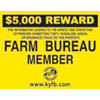Member Benefits

Membership in Kentucky Farm Bureau has its benefits, and we’re not just talking about supporting Kentucky agriculture or getting a great deal on an insurance policy. Members enjoy discounts, deals, rewards and perks from the Farm Bureau’s participating retailers and partners. Click the links below to learn more about the many ways that being a Kentucky Farm Bureau member can be a rewarding experience.
Automobile
Ford

Ford Motor Company is pleased to offer Farm Bureau members a $500 Exclusive Cash Reward on the purchase or lease of an eligible new 2024/2025/2026 Ford Maverick®, Ranger®, F-150®, Super Duty® or F-150® Lightning®. Visit fordrecognizesu.com/farmbureau today for offer details.
Ford Motor Company is pleased to offer Kentucky Farm Bureau members a $500 Exclusive Cash Reward* toward the purchase or lease of an eligible new 2024/2025/2026 model year Ford Maverick®, Ranger®, F-150®, Super Duty® or F-150 Lightning®. Not available on any other Ford and Lincoln vehicles, including F-150 Raptor® and Ranger Raptor. Vehicle eligibility may change at any time. Available to U.S. residents only. Place a new retail order or take new retail delivery from an authorized Ford Dealer's stock by 1/05/26. Limit of five purchase or leases per household during the program offer (PGM# 32524). Offer subject to dealer participation. For 2025, this offer may be used/combined with most other Ford AXZD-Plans. See an authorized Ford Dealer, or go to http://www.fordrecognizesu.com, for complete details and eligibility (PGM# 32524). Due to high demand and global supply chain constraints, some models, trims, and features may not be available or may be subject to change. Check with your local dealer for current information. Offer subject to confirmation of eligibility.

Commodity Markets
Kentucky Farm Bureau Commodities Monitoring
Financial
Farm Bureau Bank

Outside our country’s sprawling metropolises, shielded from the hustle and bustle of urban life, there are still places where face time doesn’t always include a smartphone, and connections aren’t affected by connectivity issues. Where modern mindsets meet rural lifestyles and hard work isn’t limited to a cookie-cutter 9 to 5. Places where people choose to live a little differently.
And it’s for these people that Farm Bureau Bank was created.
Farm Bureau Bank is a bank for those who want community bank relationships with large bank resources – products and services specifically designed with Farm Bureau members in mind.
PERSONAL BANKING
Checking & Savings Accounts
- Interest-bearing Performance Checking
- Money Market Accounts
- Certificates of Deposit (CDs)
- Individual Retirement Accounts (IRAs)
- Health Savings Accounts (HSAs)
Credit Cards
- Farm Bureau Member Rewards Mastercard®
- The card that pays your Farm Bureau membership dues*
- Earn triple points on gas, grocery, & dining purchases*
- Earn double points on your insurance premiums*
Vehicle Loans
- New and used auto, RV, motorcycle, ATV, personal watercraft & boat
- Up to 100% financing and refinancing
- Competitively priced protection plans
Farm Bureau® Mortgage
- Full-service, dedicated team to meet your needs
- Purchase
- Refinance
- Construction
- Home Equity Lines of Credit
BUSINESS & COMMERCIAL BANKING
Checking, Savings & Account Management
- Small to large business checking account solutions
- Money Market Accounts
- Certificates of Deposit (CDs)
- Treasury Management & Fraud Prevention Solutions
- Payroll Services through Payentry®
- Electronic Payments (ACH Services)
- Lockbox Services
- Positive Pay
- Business Online & Mobile Banking & more!
Credit Cards
- Farm Bureau Bank Premier Business Visa®
- Earn rewards on everyday purchases*
Loans
- Commercial Real Estate Loans – Owner – Occupied & Investment Real Estate
- Real Estate Secured Lines of Credit
- Working Capital Term Loans – Long & Short Terms
- Operating Lines of Credit
- Equipment Loans
To learn more about Farm Bureau Bank’s products and services, visit www.farmbureau.bank or contact a personal banker today by calling 800.492.3276.
*See product terms and conditions at www.farmbureau.bank. Farm Bureau, FB, and the FB National Logo are registered service marks owned by, and used by Farm Bureau Bank FSB under license from the American Farm Bureau Federation. Equal Housing Lender. Member FDIC. NMLS ID 2214437, visit NMLS Consumer Access for details.
Farm Bureau Mortgage

A division of Farm Bureau Bank®, Farm Bureau Mortgage’s dedicated team of mortgage experts will work with you to find the best possible home loan options to fit your exact needs and goals. Working with lenders across the country who compete for your business, our team can deliver more types of mortgage products and programs with terms to fit your situation – whether its purchasing, refinancing, building or accessing your home’s equity for a large expense.
To learn more about all our home loan options, visit www.farmbureau.mortgage today!
*Farm Bureau, FB, and the FB National Logo are registered services marks owned by, and used by Farm Bureau FSB under license from, the American Farm Bureau Federation. Member FDIC. Equal Housing Lender. NMLS ID 2214437, visit NMLS Consumer Access for details.
For The Farm
Bush Hog
.jpg) Members are eligible to receive a $250 discount off the purchase of a Bush Hog product(s) valued at $5,000 or greater. KFB Members must present a completed Discount Agreement form with your KFB Membership number to the Bush Hog dealer.
Members are eligible to receive a $250 discount off the purchase of a Bush Hog product(s) valued at $5,000 or greater. KFB Members must present a completed Discount Agreement form with your KFB Membership number to the Bush Hog dealer.
Case IH
![]()
SAVE UP TO $500 ON ELIGIBLE CASE IH EQUIPMENT
Kentucky Farm Bureau members save $500 per unit on the purchase or lease of Case IH Maxxum® and Vestrum® tractors; self-propelled windrowers and large square balers. A $200 per unit incentive is available for Case IH Farmall® C series utility, U series utility, A series utility and 100A series tractors; Farmall® C series compact and Farmall® A series compact tractors; Farmall N series and Farmall V series tractors; Other hay tools, including round balers, small square balers, disc mower conditioners and sicklebar mower conditioners. Farm Bureau members save $100 per unit on the purchase of the Case IH Farmall Compact 25A®.
Click here to find out more about the Farm Bureau Offer.
Click here to create a certificate as a Kentucky Farm Bureau Member to present to your Case IH dealer.
How to Redeem
Enter your member ID and zip code to get your discount certificate, click here. Print or download the certificate, then visit your dealer and make your best deal. Once you’ve negotiated the best price, present your discount certificate to subtract another $100 - $500 from the bottom line. Your certificate, along with valid ID, must be presented to the Case IH dealer in advance of delivery to receive the discount.
Combine the Farm Bureau offer with other discounts, promotions or rebates that may be available from Case IH or your Case IH dealer. You may use an unlimited number of discount certificates, but one certificate is required per unit. Your discount incentive will be shown on the invoice as a subtraction from the best-negotiated price. Kentucky Farm Bureau individual, family or business members qualify for purchase or lease incentives listed below with discount certificate:
If you have questions or need help obtaining the certificate, please call Kentucky Farm Bureau Member Benefits at 502-495-5106 or visit your local FB office.

Caterpillar

SAVE UP TO $2,750 ON CAT EXCAVATORS, SKID STEERS, WHEEL LOADERS AND MORE
Eligible Kentucky Farm Bureau members* can save up to $2,750 on the purchase or lease of eligible Cat® compact track loaders, compact and small wheel loaders, skid steer loaders, small dozers, backhoe loaders, mini hydraulic excavators and telehandlers. Also, receive an additional $250 credit on select work tool attachments purchased with new Cat machines (Promotion excludes Buckets, Forks, Thumbs, and Coupler attachments). These discounts can be combined with any current retail discount, promotion, rebates or offers available through Caterpillar or its dealers, with the exception of the Cat NCBA membership incentive.
For a complete list of eligible Cat equipment discounts, click HERE!
Click here to access your certificate.
*Must be a valid member of a participating state Farm Bureau to be eligible for discount. Members must present a discount certificate at time of purchase or lease quote to receive the discount. No limit on discount certificates available to members, but one certificate must be presented for each machine purchase or lease.
If you have questions or need help obtaining the certificate, please call Kentucky Farm Bureau Member Benefits at 502-495-5106.
Learn more at Cat.com/FarmBureau and get your discount certificate today!
For more information regarding how you can take advantage of this discount program, visit my.kyfb.com.
Farm Chemicals

Farm chemicals are offered once each year. Members may place an order in their county office or by emailing Debbie.Brown@kyfb.com. Orders are received in early March for products to be delivered in late March or early April. Prices are subject to change without notice. Quantities of some products are limited. Price list and order form are available in January and February for orders.
If you have any questions, please contact Matthew Ingram at 502-495-5000 Ext. 7706 or via email Matthew.Ingram@kyfb.com.
FieldClock

SAVE TIME AND MONEY WITH FIELDCLOCK
Kentucky Farm Bureau members receive $10 off monthly pricing of any FieldClock plan selected. FieldClock brings their suite of labor management solutions uniquely designed to fit the needs of farmers, ranchers and rural businesses across the country to the table. Watch a demonstration of their services and explore all that FieldClock has to offer.
Check out their different apps that provide solutions for different needs:
FieldClock: A labor management tool and time clock app for workers on your farm or business operation
Kiosk: A self-serve app for employees that report to a central location
Admin Site: A web app that provides easy management of employees, fields, exports payout data and generates reports from anywhere
Employee Portal: A self-serve web app for employees to track and manage their time and product count
Visit FieldClock.com/FarmBureau today to learn more and find the plan for you!
*This discount is available in addition to any other FieldClock discounts, promotions, rebates, or offers occasionally available.
Grainger Industrial Supply

EXCLUSIVE FARM BUREAU MEMBER PRICES AT GRAINGER!
Kentucky Farm Bureau members get deep discounts on select products and supplies from Grainger, when ordering items online, over the phone or at your local Grainger branch.
Farm Bureau members receive deep discounts on products in the following categories:

If you have questions or need assistance, please call Matthew Ingram at 502-495-7706.
For more information regarding how you can take advantage of this discount program, visit my.kyfb.com.
Grasshopper Mowers

Farm Bureau Members Save 12% off MSRP
A family-owned business with more than 50 years of manufacturing experience, The Grasshopper Company has specialized in manufacturing True ZeroTurn™ riding rotary mowers since 1969. No parent corporation or outside investors make the decisions at Grasshopper.
For 40 years, Grasshopper has studied the needs of government entities, turf care professionals and equipment owners across the nation and around the world. Grasshopper engineers continuously research and test new product features and improvements at our 300,000-square-foot facility in Moundridge, Kansas. Every Grasshopper product is engineered for performance, using only the highest quality components and heavy-duty construction to ensure long life. Their skilled manufacturing specialists use the latest high-tech equipment, including computer-aided manufacturing fully integrated with a 3-D solid modeling computer design system, CNC fabrication and machining.
Program Guidelines:
12% OFF MSRP rebate available for all models. Farm Bureau rebate valid when purchasing new, unregistered Grasshopper tractor and mowing deck. No other sales programs may be combined with this offer.
Financing available at participating dealers. See dealer for available financing offers and to apply for qualification.
Proof of Valid and Active KFB Membership Required to take advantage of this savings.
See dealer for complete Farm Bureau offer details.
Grasshopper products are available through a worldwide network of knowledgeable, independent dealers offering sales, parts and service to turf care professionals, business and government entities and discerning individuals.

John Deere Rewards

Kentucky Farm Bureau members receive an upgraded John Deere Rewards membership (Platinum 1) – which unlocks extra discounts on equipment, parts, and merchandise. Register today, and explore all that Rewards has to offer.
Details and Restrictions:
Must be a valid member of Farm Bureau for 30 days.
A valid member email address is required for eligibility.
Check out the savings on the following equipment categories:
Commercial Mowing -- $200 to $1,700 off
Residential Mowing -- $50 to $150 off
Utility Vehicles -- $100 to $250 off
Tractors -- $150 to $250 off
Compact Construction -- $550 to $1,400 off
Don’t wait – visit JohnDeere.com/FarmBureau today to register!
For The Home
AmeriGas

Kentucky Farm Bureau members receive a five cents per gallon discount at AmeriGas. Visit www.amerigas.com for more information.
*Offers subject to change without notice, some restrictions may apply, contact store for details. Offer does not apply to fixed price customers. You must provide your Farm Bureau membership number to your AmeriGas dealer prior to delivery of your propane in order to receive the discount.*
Dell

Dell and Kentucky Farm Bureau have teamed up to bring you a discount program for your purchases. Dell’s EPP gives you:
- 2 - 12% off any XPS, Dimension desktop, or Inspiron notebook as your regular EPP discount (based on price and warranty purchased.)
- Regular EPP discount is in addition to generally advertised Dell Home Sales (DHS) prices and promotions.
- Exclusive seasonal discounts not available to general public.
For more information regarding how you can take advantage of this discount program, visit my.kyfb.com.
Office Depot

Kentucky Farm Bureau has partnered with Office Depot to bring you a FREE National Discount Program. Members receive up to 86% off Preferred Products. 11,500 Additional products are discounted below retail. Farm Bureau members get free next day delivery on orders over $50 and reduced copy and print pricing at Office Depot Stores or online.
For more information regarding how you can take advantage of this discount program, visit my.kyfb.com.
Sherwin-Williams

Members receive up to a 25% discount on paint, wallcoverings and accessories at most Sherwin-Williams stores.
For more information regarding how you can take advantage of this discount program, visit my.kyfb.com.
Health
Agelity Pharmacy Discount Program

Agelity is a "no fees, no enrollment" discount prescription drug program. Agelity is honored at 56,000 pharmacies - nationwide (Target, Kroger, K-Mart, Walgreens, Rite-Aid, and hundreds of others) and good for over 12,000 prescription drugs. One card is good for your whole family.
This is NOT INSURANCE, it is only a discount.
For more information regarding how you can take advantage of this discount program, visit my.kyfb.com.
AirMedCare Network

In a medical emergency every second counts™. No one knows that better than our network of providers. AirMedCare Network (AMCN) providers respond to scene calls and provide hospital-to-hospital transports—carrying seriously ill or injured patients to the nearest appropriate medical facility.
AMCN is America’s largest air medical membership network. Even with medical insurance, air medical transport can result in significant out-of-pocket expenses, however an AMCN membership ensures no out-of-pocket expenses for medically necessary flights only if flown by Air Evac Lifeteam or any other AMCN provider.
Join AirMedCare Network’s membership at a special “members only” discounted rate! Kentucky Farm Bureau members qualify for a $20 discount off their annual membership. For more information regarding how you can take advantage of this discount program, visit my.kyfb.com.
Coast to Coast Vision

Coast to Coast Vision offers Kentucky Farm Bureau members up to 60% off regular prices on eyeglasses and contact lenses. The program is available through a network of licensed optometrists and ophthalmologists throughout Kentucky.
For more information regarding how you can take advantage of this discount program, visit my.kyfb.com.
Life Line Screening

Kentucky Farm Bureau is joining forces with Life Line Screening, the nation's leading provider of preventive screenings, to provide screening services to members at a discounted rate. Stroke affects nearly 800,000 Americans every year. Abdominal aortic aneurysms, peripheral vascular disease and atrial fibrillation, as well as high blood pressure, are silent conditions. You often do not know you have them until it is too late. If you are age 40 and over, consider these screenings to help keep you on top of your health. To find a screening in your area call 1-800-449-2350 or go to www.lifelinescreening.com/kyfb
Prescription Savings Program

Kentucky Farm Bureau Federation
Prescription Savings Coupon
This program is being provided to you and your family to help lower your prescription drug costs. Families can receive savings of up to 80% (discounts average roughly 30%) at more than 68,000 national and regional pharmacies.
THIS IS NOT INSURANCE.
For more information regarding how you can take advantage of this discount program, visit my.kyfb.com.
QualSight Lasik

As a Kentucky Farm Bureau member, you now have access to significant savings on the nation’s most popular and successful elective procedure- LASIK eye surgery! The Kentucky Farm Bureau has partnered with QualSight LASIK to bring members savings of 40% to 50% off the national average price for Traditional LASIK. QualSight’s network of the nation’s most experienced LASIK surgeons has collectively performed over 2.5 million procedures. Choose from over 800 locations nationwide for your free LASIK consultation to find out if you are a candidate for this life changing procedure.
For more information regarding how you can take advantage of this discount program, visit my.kyfb.com.
Start Hearing
 It's proven that hearing health can improve your quality of life. Start Hearing is here to help!
It's proven that hearing health can improve your quality of life. Start Hearing is here to help!
As a member of the Kentucky Farm Bureau, you and your family members have exclusive access to FREE hearing consultations, discounts up to 48% off hearing aids and our risk-free 60-day trial period through our nationwide network of hearing professionals.
For more information regarding how you can take advantage of this discount program, visit my.kyfb.com.
Identity Theft Protection
IDENTITY THEFT PROTECTION MONITORING
IDENTITY THEFT PROTECTION SERVICE
As a Kentucky Farm Bureau member, you and your family are offered a proactive detection product that informs you instantly of potentially fraudulent activity related to your credit report, scans the dark web to track down any personal data identity thieves are trading and selling and a host of additional monitoring/protection services for a discounted, low monthly fee.
For more information regarding how you can take advantage of this discount program, visit my.kyfb.com.

IDENTITY THEFT RESTORATION

IDENTITY THEFT CONSULTATION AND RESTORATION
As part of the many benefits included with your Kentucky Farm Bureau membership, you have access to Identity Theft Consultation and Restoration Services with IDX for FREE. All eligible family members in the household are covered and the service is included in your annual membership dues.
For more information regarding how you can take advantage of this discount program, visit my.kyfb.com.
KFB Insurance
Kentucky Farm Bureau Insurance
Scholarships
Kentucky Farm Bureau Scholarships
Security
Home Security Systems
K entucky Farm Bureau has negotiated an agreement with two of the top ranking security companies in Kentucky, Modern Systems Inc and PRO Security and Fire Systems, to provide Farm Bureau members with low-cost security. The counties In western Kentucky will be serviced by PRO Security and Fire Systems, the counties in central and eastern Kentucky will be serviced by Modern Systems Inc.
entucky Farm Bureau has negotiated an agreement with two of the top ranking security companies in Kentucky, Modern Systems Inc and PRO Security and Fire Systems, to provide Farm Bureau members with low-cost security. The counties In western Kentucky will be serviced by PRO Security and Fire Systems, the counties in central and eastern Kentucky will be serviced by Modern Systems Inc.
The package consists of:
- Honeywell keypad
- 2 Exterior Doors Protected
- 1 Smoke Detector
- 1 motion detector
- Yard Sign and Stickers
- Professional Installation
- Total Connect Remote Services (The ability to control your system from anywhere using your smartphone, tablet or computer)
Farm Bureau members should call 800-252-7664 to request additional information or to schedule installation.
Reward Signs
 A free reward sign to be posted by property owners: "$5,000 reward for information leading to the arrest and conviction of person(s) committing theft, vandalism, arson, or insurance fraud on posted property". Signs may be obtained at the county Farm Bureau office. Click here for Reward Conditions.
A free reward sign to be posted by property owners: "$5,000 reward for information leading to the arrest and conviction of person(s) committing theft, vandalism, arson, or insurance fraud on posted property". Signs may be obtained at the county Farm Bureau office. Click here for Reward Conditions.
Travel
Avis Rent-A-Car

PAY NOW™ AND Save up to 35% off Avis rentals
Kentucky Farm Bureau members can save up to 35 percent off Avis base rates with PAY NOW* for max savings with Avis Worldwide Discount (AWD) number. In addition, enjoy additional offers** like dollars off, a complimentary upgrade, or a free weekend day.
Avis Car Rental operates one of the world's best-known car rental brands with approximately 5,450 locations in more than 165 countries.
For more information regarding how you can take advantage of this discount program, visit my.kyfb.com.
*Discount rates may vary between 10 and 35 percent, depending on time of year, availability, selection of PAY NOW™, and other factors.
**Farm Bureau discount may NOT be stacked with other AWD corporate or membership discounts.
For more information regarding how you can take advantage of this discount program, visit my.kyfb.com.
Biltmore

Discover the timeless hospitality of Biltmore® in Asheville, NC. Your admission includes the breathtaking beauty of Biltmore House—America’s Largest Home®— a masterpiece of architecture filled with treasures and antiques. Stroll through century-old gardens bursting with blooms.
Biltmore is delighted to continue to offer guests the Biltmore Enhanced Experience, which includes the audio guide to Biltmore House. Our audio guide of Biltmore House provides a more immersive opportunity for guests to learn about the lives of the Vanderbilt family, their guests, and the employees who worked in the home. Kentucky Farm Bureau members receive value-priced admission tickets.
For more information regarding how you can take advantage of this discount program, visit my.kyfb.com.
Budget Rental Car

PAY NOW™ AND Save up to 35% off budget rentals
Kentucky Farm Bureau members can save up to 35 percent off Budget base rates with PAY NOW* for max savings with Budget Customer Discount (BCD) number. In addition, enjoy additional offers** like dollars off, a complimentary upgrade, or a free weekend day.
Budget Car Rental operates one of the world's best-known car rental brands with approximately 5,450 locations in more than 165 countries.
For more information regarding how you can take advantage of this discount program, visit my.kyfb.com.
*Discount rates may vary between 10 and 35 percent, depending on time of year, availability, selection of PAY NOW™, and other factors.
**Farm Bureau discount may NOT be stacked with other BCD corporate or membership discounts.
For more information regarding how you can take advantage of this discount program, visit my.kyfb.com.
Budget Truck Rental
 Save 20% off Budget Truck rentals
Save 20% off Budget Truck rentals
Kentucky Farm Bureau members can now save 20 percent off Budget Truck Rental!
Budget Truck Rental is one of the world's best-known truck rental brands with over 1,000 locations in the Continental United States. With over 20,000 non-CDL medium-light duty trucks in its fleet, Budget Truck has the solution you need for any project! Budget Truck Rental, LLC. is owned by Avis Budget Group, Inc., which operates and licenses the brand throughout the world.
Terms and Conditions: The Farm Bureau discount is only on reservations and cannot be applied in person at the rental counter. Discount only applies to truck rental and mileage rates and does not apply to taxes, surcharges, fees, refueling, moving supplies or optional items. Offer is not available in AK or HI and is subject to availability at participating locations; some blackout dates may apply. Rate may vary by location and seasonality.
For more information regarding how you can take advantage of this discount program, visit my.kyfb.com.
Choice Hotels

Through our partnership with Choice Hotels, Kentucky Farm Bureau members are eligible to save up to 20% off best available rates at participating Ascend®, Cambria®, Clarion®, Comfort Inn®, Comfort Suites®, Econo Lodge®, MainStay Suites®, Quality Inn®, Rodeway Inn®, Sleep Inn®, and Suburban Extended Stay® hotels. Additional savings can also be obtained by Signing up for the Choice Privileges® rewards program.
* Discount subject to availability at participating hotels and is not for use in conjunction with any other discount, offer or promotional rate. Advance reservations are required through the 800# or choicehotels.com using the discount code provided on my.kyfb.com.
Save up to 20% off published rates at almost 5,000 Choice Hotels worldwide!
For more information regarding how you can take advantage of this discount program, visit my.kyfb.com.
Dollywood and Splash Country

Dollywood family amusement park is the top destination for family vacations in Pigeon Forge, Tennessee, nestled on 160 acres in the foothills of the Great Smoky Mountains. With more than 50 rides, high-energy entertainment, award-winning dining, and a friendly atmosphere, Dollywood has plenty to offer.

Dollywood’s Splash Country is the most trusted water park in the Smokies. Discover sun-drenched fun for all ages as you plunge down towering slides or relax and float down the lazy river. There is fun for everyone.
Kentucky Farm Bureau members enjoy discounted 1- day tickets at either park ($10.00 savings per ticket to Dollywood; $10.95 savings per ticket to Dollywood’s Splash Country). The special discount is good any day the park is in operation.
For more information regarding how you can take advantage of this discount program, visit my.kyfb.com.
Drury Hotels
 Through our partnership with Drury Hotels, Kentucky Farm Bureau members are eligible to save 15% on their room rates at over 150 Drury Hotels. Drury offers three distinct options for meeting your unique needs. Whether you choose Drury Inn & Suites, Drury Plaza or Pear Tree Inn, you will always receive a warm welcome, cozy accommodations and award-winning service. In addition to free WiFi, all hotels offer a free hot breakfast and free hot food and cold beverages each evening at 5:30 Kickback®.
Through our partnership with Drury Hotels, Kentucky Farm Bureau members are eligible to save 15% on their room rates at over 150 Drury Hotels. Drury offers three distinct options for meeting your unique needs. Whether you choose Drury Inn & Suites, Drury Plaza or Pear Tree Inn, you will always receive a warm welcome, cozy accommodations and award-winning service. In addition to free WiFi, all hotels offer a free hot breakfast and free hot food and cold beverages each evening at 5:30 Kickback®.
For more information regarding how you can take advantage of this discount program, visit my.kyfb.com.
Enterprise Rent-A-Car

Great Cars. Low Rates. Free Pickup.
Save when you rent from Enterprise Rent-A-Car. With the largest fleet in North America and a wide variety of vehicles, Enterprise has you covered. Plus, we're always nearby with over 6,500 fully staffed neighborhood and airport locations. Pick Enterprise. We’ll Pick You Up®.
For more information regarding how you can take advantage of this discount program, visit my.kyfb.com.
GREAT SMOKY MOUNTAIN ATTRACTIONS

Multiple discounts available for members of Kentucky Farm Bureau including several attractions in the Great Smoky Mountains, such as Dolly Parton’s Stampede Dinner Attraction, Pirates Voyage Dinner & Show, Hatfield & McCoy Dinner Feud, and more! You may receive $3 off each adult ticket (up to six) in the party. This discount is available in person, over the phone, or online. You must sign in to our membership portal to access this discount code.
For more information regarding how you can take advantage of this discount program, visit my.kyfb.com.
Great Wolf Lodge

Clear your calendar, pack your swimsuits, and head to Great Wolf Lodge! Just imagine... a colossal indoor water park, 100 game arcade, and fantastic restaurants- all under one roof! Adventure awaits... we hope your family can create new traditions at Great Wolf Lodge very soon!
Great Wolf Lodge offers Kentucky Farm Bureau members a 15% discount on the best available room rates at our Mason, Ohio Lodge when booking using the KFB Discount code.
For more information regarding how you can take advantage of this discount program, visit my.kyfb.com.
Holiday World
 Holiday World celebrates Christmas, Halloween, Thanksgiving and the 4th of July with roller coasters, family rides, live shows, games, and attractions. Thunderbird, the nation’s only launched wing coaster, has been featured on the Travel Channel and HGTV. TIME magazine named Holiday World’s Voyage the nation’s #1 wooden roller coaster. Splashin’ Safari has been named the Nation’s Best Waterpark by USA Today, which includes the two longest water coasters in the world (certified by Guinness World Records); two wave pools, numerous family raft slides and water slides, plus a new junior wave pool and slide complex for smaller children. Both parks provide free soft drinks, free parking, free inner-tube usage, free sunscreen, and free Wi-Fi.
Holiday World celebrates Christmas, Halloween, Thanksgiving and the 4th of July with roller coasters, family rides, live shows, games, and attractions. Thunderbird, the nation’s only launched wing coaster, has been featured on the Travel Channel and HGTV. TIME magazine named Holiday World’s Voyage the nation’s #1 wooden roller coaster. Splashin’ Safari has been named the Nation’s Best Waterpark by USA Today, which includes the two longest water coasters in the world (certified by Guinness World Records); two wave pools, numerous family raft slides and water slides, plus a new junior wave pool and slide complex for smaller children. Both parks provide free soft drinks, free parking, free inner-tube usage, free sunscreen, and free Wi-Fi.
For more information regarding how you can take advantage of this discount program, visit my.kyfb.com.

Kentucky Kingdom & Hurricane Bay

Laugh, slide, and play all day with more than 70 fun-filled rides and attractions, interactive entertainment, and all-new family events all in the heart of Louisville, KY!
For more information regarding how you can take advantage of this discount program, visit my.kyfb.com.
Kentucky State Park Lodges
 10% off regular rate of lodge or cottage. Show your Kentucky Farm Bureau membership card at time of registration. For more information, visit parks.ky.gov.
10% off regular rate of lodge or cottage. Show your Kentucky Farm Bureau membership card at time of registration. For more information, visit parks.ky.gov.
Red Roof Inn

Kentucky Farm Bureau members save 20% year-round at any Red Roof nationwide!
Red Roof® has over 500 properties across the United States and is growing internationally with 3 locations open in Brazil, 2 properties open in Japan, and others to follow in Thailand and Canada.
The primary goal at Red Roof is to provide customers a savings without sacrificing comfort.
For more information regarding how you can take advantage of this discount program, visit my.kyfb.com.
Wyndham Hotels

Kentucky Farm Bureau has partnered with Wyndham Hotels & Resorts to offer KFB members savings of up to 20% off the Best Available Rate* at participating hotels worldwide. On top of your discount, Wyndham Rewards members also earn Wyndham Rewards points on qualified stays.
With a portfolio of more than 20 trusted brands, including La Quinta, Days Inn, Super 8 and Hawthorn Suites, Wyndham Hotels & Resorts welcomes travelers with more than 9,000 hotels across nearly 95 countries around the globe. You’ll find a diverse mix of hotels for road trips, beachfront getaways, airport layovers, and everything in between. Wherever you go, Wyndham will be waiting to welcome you.
*Best Available Rate is defined as the best, unrestricted, non-qualified, publicly available rate on the Internet for the hotel, date and accommodations requested. Certain restrictions apply. Advanced reservations are required. Offer is subject to availability at participating locations and some blackout dates may apply.
For more information regarding how you can take advantage of this discount program, visit my.kyfb.com.